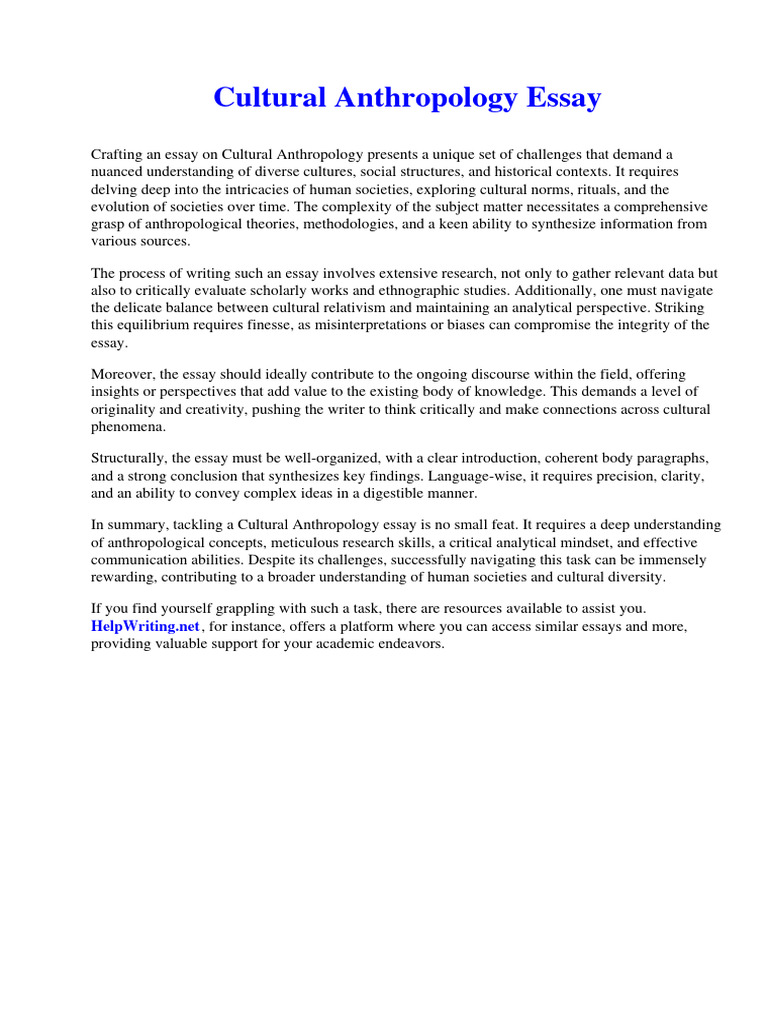Cultural anthropology is a multifaceted discipline that delves into the complexities of human societies, examining the myriad ways in which culture shapes our lives. When exploring cultural anthropology essay examples, readers can anticipate a range of content types, each with its own thematic focus and methodological approach. This discourse will traverse the various genres of essays within the field, elucidating the core components that make them both informative and engaging.
One prevalent type of cultural anthropology essay is the comparative analysis. Such essays juxtapose different cultural practices or belief systems, shedding light on the underlying social mechanisms that drive these variations. For instance, an essay might explore the rites of passage in various societies, comparing Indigenous traditions with contemporary Western practices. This is not merely an academic exercise; it fosters an understanding of cultural relativism, encouraging readers to appreciate the richness of human diversity without ethnocentric biases.
Another prominent form is the ethnographic essay. Ethnography is a foundational method in anthropology, involving immersive observation and participation in a community’s daily life. An essay detailing an ethnographic study might focus on a specific cultural group, such as the !Kung people of the Kalahari Desert. This type of content typically integrates vivid, descriptive elements that capture the nuances of social interactions, rituals, and the environmental context. By employing an evocative narrative style, the ethnographer invites readers to experience the culture vicariously, promoting empathy and a deeper understanding of the subject matter.
Furthermore, theoretical essays play a crucial role in cultural anthropology. These essays often engage with prominent theories, such as structuralism, post-colonialism, or cultural materialism, to frame discussions about culture. A theoretical essay might dissect the interplay of power and representation in cultural artifacts, utilizing seminal works from anthropologists like Claude Lévi-Strauss or Michel Foucault as a springboard for analysis. Here, readers can expect a rigorous engagement with conceptual frameworks, encouraging them to think critically about how cultural narratives are constructed and disseminated across different societies.
Case study essays provide a complementary approach to understanding cultural phenomena. These essays often focus on specific events or trends that epitomize broader cultural themes. For example, a case study might examine the impact of globalization on local customs, such as the commercialization of Diwali in India. By providing a detailed account of a particular situation within its cultural milieu, case study essays illuminate the dynamic interplay between local and global forces. This approach not only enriches the analysis but also underscores the relevance of cultural anthropology in contemporary discussions about identity and change.
Thematic essays represent another exciting avenue within cultural anthropology literature. These essays explore overarching themes such as gender, identity, or ritual. For instance, an essay on gender roles in different cultures could examine how varying societal norms shape men’s and women’s experiences. Through comparative analysis, the essay might reveal stark contrasts and unexpected similarities in the ways different cultures perceive and enact gender. This type of content encourages readers to engage with pressing social issues, fostering a critical consciousness about the cultural constructs that underpin everyday life.
Moreover, advocacy essays harness the insights gleaned from cultural anthropology to address contemporary sociopolitical issues. By utilizing anthropological perspectives, these essays often highlight marginalized voices and draw attention to injustices. For instance, an advocacy essay might explore the plight of indigenous populations facing climate change, articulating how their traditional ecological knowledge can inform sustainable practices. Such essays not only serve to inform but also galvanize readers to take action, reminding them of the urgent need for social justice and environmental stewardship.
In addition to these academic forms, creative cultural anthropology essays make use of narrative techniques typically found in literature. These essays may weave personal anecdotes with anthropological insights, blurring the lines between scholarly work and storytelling. A creative essay may recount the author’s transformative experiences during fieldwork, juxtaposing personal revelations with broader cultural observations. This approach invites readers to reflect on their own lives, fostering a sense of connection between the academic discourse and individual experience.
Finally, reflective essays provide an introspective look into the anthropologist’s journey. These essays often detail the research process, ethical dilemmas faced during fieldwork, and the scholar’s evolution in understanding cultural dynamics. By reflecting on their own biases and perceptions, authors contribute to the conversation about reflexivity in anthropology, reminding readers of the subjective nature of research. Such essays not only enrich the intellectual landscape but also cultivate a deeper appreciation for the complexities of human behavior.
In conclusion, cultural anthropology essays encompass a diverse array of content types, ranging from comparative analyses and ethnographic studies to theoretical explorations and advocacy pieces. Each genre contributes uniquely to our understanding of the intricate tapestry of human societies. Whether through the lens of narrative or rigorous empirical analysis, these essays underscore the importance of cultural anthropology in deciphering the world around us. By engaging with this literature, readers can gain valuable insights into the multifaceted relationships between culture, identity, and global issues, ultimately fostering a greater sense of awareness and responsibility in an increasingly interconnected world.
